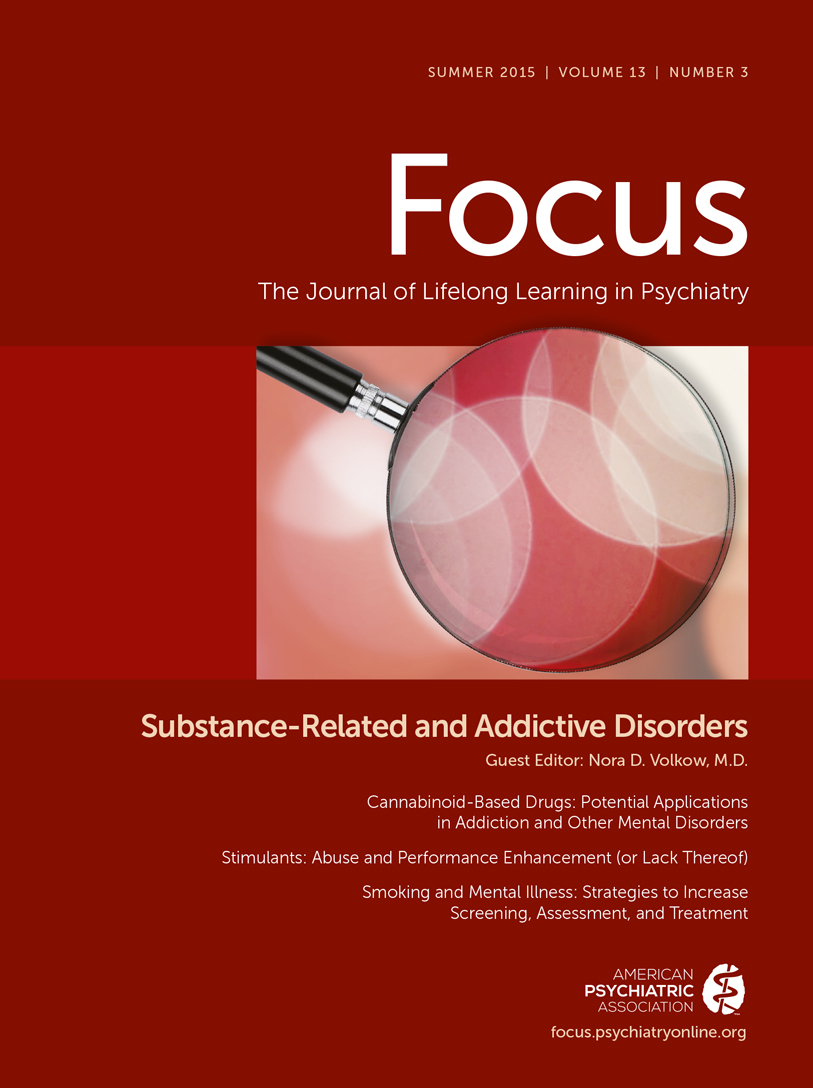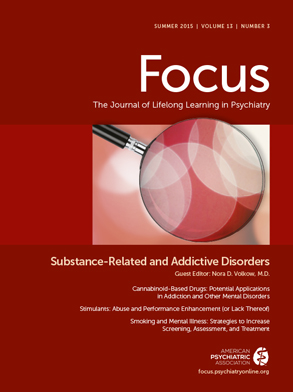The National Institute on Drug Abuse (NIDA) Centers of Excellence for Physician Information Program has developed teaching tools for medical students, residents, practicing physicians, and medical educators to improve the effectiveness of screening tools and interview techniques for identifying substance use disorders in patients assessed. Among the tools are curricula, screening tools, educational videos, and general suggestions regarding taking a substance use history and inquiring about other sensitive subjects and high-risk behaviors. Some of these patient assessment measures were developed jointly with APA as “emerging measures” for further research and evaluation (
3). These assessment tools were designed to be administered at the initial patient interview and to monitor treatment progress. One of these measures is the Alcohol, Smoking and Substance Involvement Screening Test (ASSIST). The test was initially developed by the World Health Organization, and APA adapted this screening assessment from the NIDA Modified ASSIST (
2) as well as the NIDA Quick Screen (
4) to be used as potentially useful tools to help patients and their caregivers identify and quantify their substance use.
Clinical Vignette
Mr. Brown stepped into the office, giving Dr. Joshi a firm and confident handshake and flashing a too-broad smile. Dr. Joshi returned the smile warmly, and they sat down.
“So, Doc,” Mr. Brown started. “Dr. Miller, my primary care doctor, said that you could help. He thinks that anxiety is adding to my blood pressure problems.”
Dr. Joshi nodded empathically and inquired, “And what do you think?”
“Well, I have been stressed a lot. I mean, there have been layoffs at work and I am worried I could be next,” Mr. Brown said.
Dr. Joshi inquired about the patient’s social, developmental, and family history, psychiatric history, and medication use. Anxiety and depression were noted in family members, and Mr. Brown’s grandfather had been an alcoholic. Mr. Brown had never been in psychiatric treatment, although he and his wife had gone to couples therapy approximately 6 months ago for several sessions when they were having marital disagreements “about money and raising the kids.” Mr. Brown had two children, ages 15 and 17 years, who were in their “rebellious” stages, but “they are pretty good kids overall. Their grades are good, and they want to go to college. I just hope I can afford it…,” Mr. Brown’s voice trailed off.
Dr. Joshi nodded compassionately. “It sounds like it has been a very hard year for you. I’m sorry to hear that.” She paused briefly and then added, “You know, each of us manages stress in different ways. Some of us get depressed and withdrawn, some drink a bit more, and some find that they are cranky or not sleeping very well. Let’s review which of those you have been experiencing.”
Dr. Joshi began with open-ended questions and then asked specific questions. Mr. Brown had completed the ASSIST screening measure (
2) in the waiting room, and Dr. Joshi asked if they may review it together.
Mr. Brown looked somewhat embarrassed, but he agreed.
“Okay,” Dr. Joshi noted matter-of-factly. “It seems that stress may be affecting your drinking. Alcohol can help you feel less stressed and worried. As you may know, however, drinking can backfire by becoming another problem. Drinking can also interfere with restful sleep,” Dr. Joshi explained. “You noted that you have been drinking more than usual lately.”
Mr. Brown nodded affirmatively. “My wife thinks I have a problem, and she has been nagging a lot about it. But I think she is overreacting. She tends to do that.”
“Thank you for telling me that,” Dr. Joshi mused, smiling appreciatively. “I hope this also means that you will feel comfortable being honest about your answers to the specific questions about your drinking. I’ll try not to nag,” Dr. Joshi said, smiling again. This time, Mr. Brown’s smile was wide and genuine.
Dr. Joshi took a detailed substance use history, and she determined that drinking was becoming impairing for Mr. Brown. He was falling asleep with a beer in his hand in front of the TV every night, and his kids said that he embarrassed them when they had friends over. He did not drink in the morning, but he admitted that he was not as sharp as he used to be. He was anxious and self-deprecating.
“My confidence is shot,” Mr. Brown concluded. “Maybe that’s why I take one,” he said. Dr. Joshi looked briefly puzzled. “You know. That’s why I take a shot—of booze. Sorry, bad joke on my part,” Mr. Brown said.
Both Mr. Brown and Dr. Joshi smiled at this attempt at humor with mutual understanding. Mr. Brown agreed to try Alcoholics Anonymous in the coming week. He set reasonable goals for himself, and he made a follow-up appointment.
“You aren’t going to tell my wife, are you? I just can’t deal with her saying ‘I told you so.’”
“No,” Dr. Joshi confirmed. “This is confidential.”
“Whew! Well, thanks, Doc. I feel better already. Wish me good luck!”
“Good luck,” Dr. Joshi replied warmly, as they shook hands—with less gusto and more sincerity than the handshake when they met.

